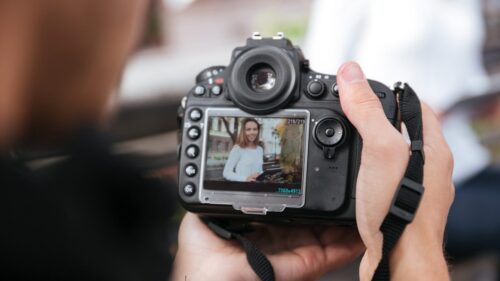Lower Thirds in After Effects With Kyle the Storyblocks Video Guy
Hey there! I’m Kyle the Storyblocks video guy. Are you constantly seeing dope lower-thirds but wondering how you can recreate them? Today I’m going to be showing YOU how to design a lower third in After Effects for your next project.
What to do before creating a lower third in After Effects
Alright! Now that we’ve found a little bit of our inspiration, we’re going to dive right into After Effects. Let’s start by getting organized.
First, we want to create a few bins. The first bin I’m going to make will be for footage. Then we’re going to make another bin for composition, solids, and inspiration.
Next, let’s go ahead and start bringing in some of our footage. This footage was downloaded from Storyblocks’ library! Now that we have our inspiration brought in, we’re going to create our composition and call it “Instagram lower third”.
Within that composition, we’re going to change the dimensions to 1080x 1350 – that’s the 4×5 aspect ratio you see on Instagram. Since I downloaded my footage off Storyblocks, I know that the footage is 24 frames a second, so I’m going to set my composition frame rate to match. For the duration, I like to set it around 15 seconds because it gives you wiggle room. You can leave the background black.
How to design a lower third
Let’s take a look at the inspiration that we have. We have two boxes that animate into the frame, and then the words follow. To start, we’re going to create this graphic that we see here in our inspiration without any animation.
Step 1 Lower Third in After Effects: Create title graphic boxes
- Select composition
- Go to layer > new shape layer
- Create the box that the title is going to be in
- Name the layer to match the title
- Create another shape layer
- Create another box that the description will go inside of
- Rename that layer to match the description
Now that we have those boxes made, we’re going to go ahead and change the parameters for the box that surrounds the title graphic. Turn off the fill and set a weight of about six for stroke. Next, we will create our text.
Step 2: Add text to title graphic and format
- Go to the text tool on the toolbar
- Type in your title
- Shift text into the box, making sure that you’re sizing it up correctly and holding shift while sizing it to maintain proportions
- Select both the title and outline layer and shift it up so that it’s in line with the title texts that we just created.
- Go to the align window (If you don’t see this on your computer, you can just go to the window and then align)
- Click these align layers to the selection and center them
Something that I also like to do is to position my anchor points right in the middle.
Step 3: Use anchor points to position your title graphic
- Select your anchor point
- Hold command, and shift it right into the middle of that text layer
- Click V on your keyboard or go up to this arrow tool
- Select the title outline
- Go back up to the anchor point tool
- Shift the anchor point and hold command so that it’s right in the middle of that description
Step 4: Repeat for photographer layer and description
We’re going to repeat that same process for the photographer layer and description. Start by selecting the photographer layer and clicking S to scale. In our inspiration, we can see that the title is in all caps and it’s bold. In our composition, double-click the layer to select all of the characters and change this font to Source Sans Pro Black – and that looks pretty good! This is just a design decision, but I’m going to set the tracking a little bit higher on those characters.
Step 5: Update description
Now, we’re going to do the same thing to our description. Double-click on that layer and go into Source Sans Pro, this time using the regular font. Then go back to the align panel, align layers to the selection, and make sure that they’re centered up both ways. Do the same thing by selecting our name and title box and aligning those layers to selection and centering them. Next, you will want to go ahead and zoom out just a little bit. Come down to the bottom left, where it says “Choose grid and guide options,” and turn on title action safe. With both of those layers selected, grab and shift them into the bottom right third of our frame.
Now, with everything selected, we’re going to move that back into position. In our inspiration, we can see that the path doesn’t go all the way around. So go back to the title box and click add trim paths. Once we get down to trim paths, as we play with this parameter we can see that it is trimming the path of that box. So we’re going to play with this to where we see fit. In our inspiration, we can see it comes around – it starts at the top of the title, comes around, and then ends near that first letter at the end. So we’re going to shift it into that same position.
Final step for creating a lower third in After Effects: Colors
We’re nearly there! We’re going to select our main title and change it from white to blue (hex code 41BFE9). Next, we’re going to select our outline and make it white. Then we’re going to come down here to the photographer. We can see that right now, our photographer’s color is white. Now, this is important, the photographer’s color has to be white for this effect to work. Select the photographer layer and move it directly on top of this description box. Then, select alpha inverted matte photographer so now the photographer’s title is see-through. If we toggle alpha, we can see right through that title. And there you have it, the design is done!
Thats all it takes to create your own lower third in After Effects. In the next video, we’re going to be showing you how to animate your design and bring it to life.
Check back for the next episode of Kyle the video guy – coming soon!



